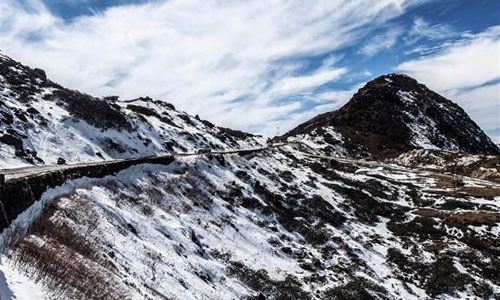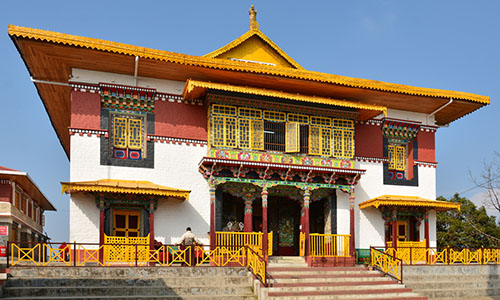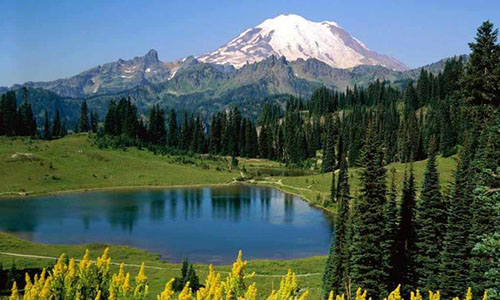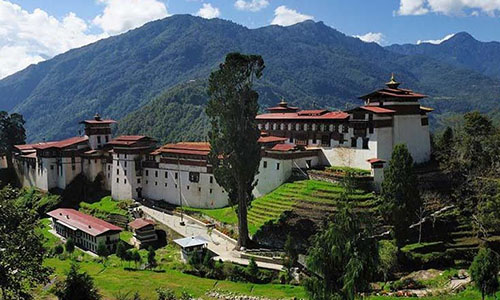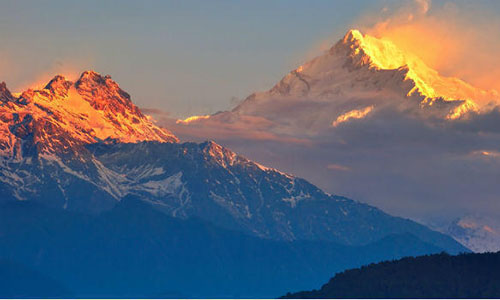Sikkim
“Home to the Kanchenjunga”
A Glimpse of Sikkim Tourism
 Sikkim, the smallest state of India, is the land of large variety of plants, animals, rivers, mountains, lakes and waterfalls. The mountain peaks, holy lakes, ancient monasteries, orchid nurseries and stunning trekking routes make Sikkim a perfect Holiday destination for you.
Sikkim, the smallest state of India, is the land of large variety of plants, animals, rivers, mountains, lakes and waterfalls. The mountain peaks, holy lakes, ancient monasteries, orchid nurseries and stunning trekking routes make Sikkim a perfect Holiday destination for you.
The north eastern charm coupled with the majestic Himalayan snow makes Sikkim one of the most beautiful state of the country. Sikkim is endowed with excellent natural resources, gorgeous mountains, beautiful waterfalls and some wonderful landscapes. The ethnic people and the natural beauty, along with modern city life give the city its own character. The Nepalis called this state as ‘Sukhim’ or the New Place, the Bhutias called it as the ‘Demazong’ or the Valley of rice and the Lepchas called it as the ‘Nye-mae-el lang’ or the abode of the Gods. If you are the one whose aesthetic sense is superb, and the one who longs to spend a moment in the lap of Mother Nature then Sikkim invites you with clear sky and fresh air.
Local Food and Cuisine of Sikkim
Sikkimese cuisine follows pretty much the same pattern as it derives its flavors ingredients, styles and elements from Nepal, Bhutan, Tibet and India, together. It draws inspiration from all that’s around and the numerous cultures and religions that it, itself fosters to give you a cuisine that is authentic and defines the area.
Sikkim is a subtle and natural blend of everything in and around. It gives birth to a unique culture which is colourful and twinkling and with which a huge part of the North-East is identified. While staple items of the cuisine are Momos, Thukpa and a local beer ‘Chang’, fermented foods are popular given the natural conditions. Rice is almost essential in each meal. Add to it a dash of authentic and splendid soups, pickles and handful of meat and vegetable delicacies and you get the colourful and tasteful cuisine of Sikkim.
What’s Great?
Enchanting sceneries. Pleasant weather throughout the year. Not overcrowded. Friendly people.
What’s not so Great?
Some areas are prone to landslides in monsoons.
For Whom?
Sikkim is perfect for nature fanatics and adventure fiends. Ideal for those who believe in Buddhism.
People and Culture of Sikkim
Sikkim has an interfusion of diverse communities, cultures, religions and customs. The leading communities in Sikkim are the Lepchas, Bhutias and Nepalese. The people of Sikkim are warm, simple, friendly and slightly shy but they love to celebrate. The Sikkimese culture finds expression in its beautiful arts and crafts. Languages spoken in Sikkim are Nepali, Bhutia and Limbu. The working language of the government is English and Hindi is the official language.
Geography of Sikkim
Sikkim is located in Eastern Himalayas. It shares its borders with Tibet on the north, Nepal on the west, Bhutan on the east and West Bengal to its south. The world’s third highest peak, Kanchenjunga is located on the Nepal-Sikkim border. Tista is the largest river of Sikkim and Rangeet is another major river of the state. About one-third of the state is heavily forested.
The Himalayas surround the northern, eastern and western borders of Sikkim. You can enjoy the scenic views of mountains covered with snow in winters and with lush greenery in summers. Hot springs are also there in Sikkim which is renowned for their medicinal values. Gangtok, the largest city, is also the capital of the state.
History of Sikkim
The history of Sikkim takes us back to the time when Lepchas were the original inhabitants of the state. It is known that Buddhist Saint Guru Rinpoche passed through the land in the 9th century and introduced Buddhism in the state. Buddhism took its distinctive Sikkimese form four centuries later, when three Tibetan monks, dissatisfied with the rise of the reformist Gelukpas, migrated to Yoksum in western Sikkim. Over the centuries, the territory was lost to the Bhutanese, the Nepalese and the British. After the Independence from British rule in 1947, Sikkim remained an independent country. Then, on 26 April 1975, it became a part of India and the 22nd state of the country.
Festivals of Sikkim
The people of Sikkim celebrate scores of festivals with great fervour and enthusiasm. Some of them are-
Losoong Festival- This is held to celebrate the end of harvest season and also the end the tenth month as per Tibetan calendar. People pray for good harvest and better prospects for the coming year.
Losar Festival- It takes place in February to celebrate the Tibetan New Year. Yak dance is performed, and processions are carried out.
LhababDheuchen Festival- This one represents the descent of Lord Buddha from the heaven after teaching his deceased mother. The Buddhists celebrate this event with all zest and zeal in Sikkim.
Kagyed Dance Festival– It takes place in around December. The dance performed by monks portrays the destruction of evil forces, and they wish for peace & prosperity in Sikkim.
Pang Lhabsol- This festival actually celebrates the Independence Day of India. The people of Sikkim on behalf of our country seek God’s blessings on this day.
Traditional Costumes of Sikkim
Traditional attire of the state is novel and very different from the rest of India. There are three communities in Sikkim- Lepchas, Bhutias and Nepalis. They all have different styles of dressing. The traditional dress for females of Lepcha community is Dumdyam or Dumvum, Tago, a loose blouse, Nyamrek or belt and Taro. Lepcha women decorate themselves with traditional ornaments like Namchok, Lyak, Gyar. The females of Bhutia community wear Kho or Bakhu, Hanju, a full-sleeve blouse of silk fabric, Kushen, Shambo and Shabchu.
Gold is an obsession for this community and most of the jewellery items are made up of pure gold. When it comes to Nepali women, they prefer to wear Pharia, a saree with ChaubandiCholo, a loose blouse. TharoCholo is one more variety of blouses worn by the women of this community. Lepcha males’ traditional costume is called Thokro-Dum, which consists of white pajamas, Yenthatse and Shambo. The traditional attire of Bhutia males is a Kho or Bakhu which is a loose piece of cloth tied at one side of the neck and waist with a belt. Bhutia males also wear JyaJya, Yenthatse, Kera and Shambo. Nepali males of Sikkim follow their own culture and tradition with respect to their costumes. They wear Shurval, Daura, Aaskot and Patuki.
Adventures in Sikkim
Sikkim offers you wide variety of thrilling adventures. For trek-lovers, Goechla Trek is the best. You will get to walk through the dense forests and picturesque meadows. River rafting in Teestariver is another adventure which will surely give an adrenaline rush. Yak ride near Tsomgo Lake is also exciting. The yaks are covered with vibrant woollen clothes, bells and strings are hung around their neck.
Biking route in Sikkim from Gangtok to Rangpo is perhaps the longest mountain biking route. The beautiful landscapes with lush greenery can best be viewed from the high mountains. Cable car ride in Gangtok should be added to your to-do-list. It gives you an opportunity to witness the stunning views from the highest point of the city.
Art Forms of Sikkim
There are many art forms which are practised in Sikkim and therefore shopping in the state is never a dull experience.
Carpet Weaving- The Bhutia Community primarily practices the art of weaving. Jute and other rugged materials are used to make best quality rugs.
Wood Carving– Wood carving is a symbolic art of Sikkimese people. Furniture of different designs is made from wood carvings.
Thangka paintings– They are exclusive to the state. The Thangkas are made on cotton canvas, and then drawings are of priests and monks of the Buddhist tradition.
Other Handicrafts– This include Sikkim shawls, jackets, bags and woolen blankets of striking designs and patterns.
“The base of Kangchenjunga”
West Sikkim Tourism “The base of Kangchenjunga”
West Sikkim, located at the foothills of Mount Kanchenjunga, offers one of the best views of Southeast face of Mt. Kangchenjunga.
West Sikkim offers one of the best views of the south-east face of Mt. Kangchenjunga. This place is also famous for few of the oldest and holiest Buddhist Monasteries of the world. With the beautiful amalgamation of nature and religious history, the calm and peaceful environment of PelSling makes it a famous tourist destination in Sikkim. West Sikkim owes its tranquility and calmness to the beautiful and age-old monasteries like Sangachoeling and Pemayansgtse Monasteries. The Kchehepalri Lake, situated in the midst of a dense forest is considered holy and is mesmerizing to devotees and tourists alike.
North Sikkim Tourism
One of the most uninhabited areas of the country, yet extremely beautiful and charming, North Sikkim shares its boundary with China and Nepal.
Mangan is the district headquarter of North Sikkim district. It is one of the most mystically beautiful though unexplored areas due to the harsh conditions found here. Located at an altitude of 956 meters the town of Mangan serves as a base for trekking and hiking trips in the mountains and forests. North Sikkim is famous for the Gurudongmar Lake which is one of the highest lakes of India. It also has religious importance. Apart from lakes, there are some important monasteries in this area too.
South Sikkim Tourism
Surrounded by beautiful forests and majestic hills, South Sikkim is the perfect vacation spot for someone looking for a retreat in the midst of nature in its most natural form.
The town of Namchi is the headquarters of South Sikkim and it is situated at an altitude of 5500 feet at a distance of around 100 kms from Gangtok. South Sikkim, since years has been famous for its monasteries and stupas and devotees flock to this town for its religious significance. But recently, this district has risen to the position of an eminent tourist destination. Ralang Monastery, SiddheswaraDham, Statue of Guru Rinpoche are among the popular attractions here.
Other Trips
These are other trips.





